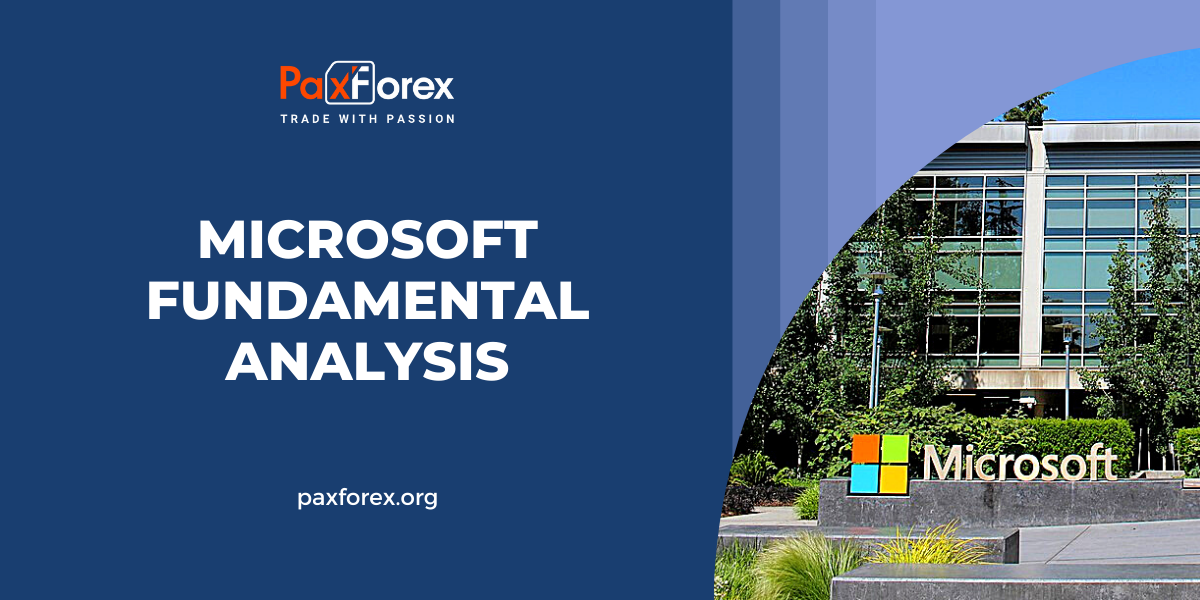
Source: PaxForex Premium Analytics Portal, Fundamental Insight
When Microsoft reported its earnings for Q2 of the fiscal year 2023, management told Wall Street what was already expected. For example, everyone knows that the short-term outlook looks very bleak because of the unfavorable macroeconomic situation.
If you want to short Microsoft, you can rely on the fact that revenue growth is sluggish and the outlook for the next quarter is less than estimated as a talking point. But if you're a fan, the company has highlighted several long-term growth drivers as conditions for investors to favor the stock today.
One of those growth drivers that investors are most enthusiastic about is what Microsoft CEO Satya Nadella calls "the next big wave of computing emerging" - artificial intelligence (AI). Nadella thinks that those leading this new wave of computing will reap enormous corporate value. And if you follow his recent actions, Microsoft aims to become a leader in AI.
You may wonder whether Microsoft has what it takes to position itself as a leader in AI in the face of serious competition from companies like Alphabet and whether it can monetize these capabilities enough to give people a serious reason to invest.
Let's try to figure it out.
Until recently, Alphabet and Meta Platforms attracted the most attention from consumers, developers, and investors as the leading AI companies. In late November, however, an innovative company called OpenAI published an AI model on its website that some people believe could change the online search experience. Then, a few months later, two days before Q2 of the fiscal year 2023 earnings were published, Satya Nadella's company made a major investment in OpenAI, and it became official: Microsoft had finally entered the AI race.
Although Nadella didn't provide financial details of the deal, the Semafor news site published rumors that the terms the two sides agreed to were that Microsoft would provide $10 billion in funding and return "receive 75% of OpenAI's profits until it recoups its investment." After that, Microsoft would own 49% of OpenAI. It would also become the exclusive cloud computing provider of OpenAI.
It didn't take long for investors to evaluate the possibility of Microsoft using OpenAI to make AI products more popular than Google - and they endorsed the idea. As a result, the company's stock has risen 10 percent since it announced its investment in OpenAI.
The new AI model that OpenAI unveiled to the world in November 2022, which has many observers so excited about, is a machine learning model called Chat Generative Pre-trained Transformer, or ChatGPT. This AI has many innovative applications, from translating one language into another to generating working computer code to coherent writing on any topic. But most notably, ChatGPT can work as a chatbot for customer service and create responses to human questions that are virtually indistinguishable from natural human dialogue.
The OpenAI model quickly became an Internet sensation, with more than 1 million users within a week of its release. Many believe it had already reached 100 million monthly active users by the end of January, exceeding the growth rate of TikTok and making it the fastest-growing app of all time.
Microsoft is already using ChatGPT in its products. On Feb. 1, for example, the company announced it was incorporating ChatGPT into Microsoft Teams Premium, its virtual meeting product. If ChatGPT proves to be as useful a product as its current popularity implies, you can expect OpenAI models to appear in more Microsoft consumer and enterprise products.
If you've read a lot of articles about OpenAI and ChatGPT over the past two months, you might think that Microsoft's investment in AI will have an immediate positive return. But take your time; there's a flip side to the coin.
First, the technology is still experimental, and it may take years for the investment in AI to pay off. For example, everyone should pay attention to the huge computational costs required to run ChatGPT. Yet, Microsoft will have to figure out how to lower those costs and how to monetize OpenAI's machine learning models in a way that's affordable to customers. If it can't do that, ChatGPT might become nothing more than an expensive toy.
Suppose you buy Microsoft because of its potential to become a leader in AI. In that case, you are counting on the company and OpenAI to figure out how to improve ChatGPT's answers (they are still imperfect, despite the hype), make the AI service profitable, and deal with legal problems, such as the copyright class action lawsuit that its Copilot program, which generates AI code, has faced.
However, if former Google employees Paul Buchheit and Sridhar Ramaswamy are to be believed, Google's main star, search, could be threatened by ChatGPT within a few years, helping to fulfill Satya Nadella's dream of leading the world's leading AI company.
As long as the price is above 250.00, follow the recommendations below:
- Time frame: D1
- Recommendation: long position
- Entry point: 263.50
- Take Profit 1: 277.00
- Take Profit 2: 295.00
Alternative scenario:
If the level of 250.00 is broken-down, follow the recommendations below:
- Time frame: D1
- Recommendation: short position
- Entry point: 250.00
- Take Profit 1: 238.00
- Take Profit 2: 230.00













